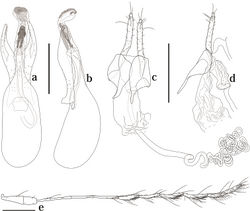Scaphicoma quadrifasciata
| Notice: | This page is derived from the original publication listed below, whose author(s) should always be credited. Further contributors may edit and improve the content of this page and, consequently, need to be credited as well (see page history). Any assessment of factual correctness requires a careful review of the original article as well as of subsequent contributions.
If you are uncertain whether your planned contribution is correct or not, we suggest that you use the associated discussion page instead of editing the page directly. This page should be cited as follows (rationale):
Citation formats to copy and paste
BibTeX: @article{Ogawa2014ZooKeys403, RIS/ Endnote: TY - JOUR Wikipedia/ Citizendium: <ref name="Ogawa2014ZooKeys403">{{Citation See also the citation download page at the journal. |
Ordo: Coleoptera
Familia: Staphylinidae
Genus: Scaphicoma
Name
Scaphicoma quadrifasciata Ogawa & Löbl sp. n. – Wikispecies link – ZooBank link – Pensoft Profile
Diagnosis
Body bicolorous: basic color yellowish-brown, elytra each with black fasciae and black along sutural and lateral margins. Ventral surface with iridescent luster due to microsculptures. Antennomere VI about two times as long as III; IV and V each shorter than VI; XI about 1.6 times as long as VIII. Protarsomeres I–III and V about two times as long as IV. Mesotarsomeres I about 1.8 to 2.0 times as long as II; II, III and V each about 1.2 times as long as IV. Metatarsomeres I about 1.5 to 1.7 times as long as II; II and III each about 1.2 times as long as IV and V; IV almost as long as V. Parameres enlarged at subapical portion and tapering to apex, weakly pointed around subapical portion in dorsal view.
Description
Body shining. Head, mouthparts and antenna yellowish-brown, except for antennomeres VII–XI dark yellowish-brown. Basic color of dorsal surface yellowish-brown, pronotum ochraceous or darkened on disc, black along margins. Elytra each with two black fasciae and black along suture and lateral margins (Fig. 1c). Posterior margins of anterior fasciae extended to apex along sutural striae, not reaching to sutural striae. Posterior fasciae extended to apex, reaching to sutural striae. Propygidium and pygidium from in basal half black, pygidium from mid-length to apex brown. Ventral surface almost black and with iridescent luster due to microsculptures. Coxa, ventrite I and II and femora, tibiae and tarsi yellowish-brown. Head, pronotum and elytra sparsely and finely pubescent.
Head with interocular distance almost as eye width. Punctuation sparse and fine. Antennomeres I–VI with a few macrosetae, VII–XI covered with some microsetae; VI about two times as long as III; IV and V each shorter than VI; VII almost as VIII; XI about 1.6 times as long as VIII (Fig. 4e). Pronotum almost as wide as long, lateral keel invisible in dorsal view. Punctuation sparse and fine, as on head. Scutellum concealed.
Elytra longer than wide, widest at basal 1/6, gradually narrowed to apex, with minute serration at inner part of posterior margin. Punctuation coarser than on pronotum. Sutural striae extending outwards along basal margin to form basal striae, reaching humeral area and not joined with lateral striae.
Propygidium sparsely and coarsely punctuate. Pygidium with sparse, fine and also coarse punctures.
Hypomeron finely punctuate. Lateral portion of mesoventrite coarsely and sparsely punctuate; medial portion finely and sparsely punctuate, with fine pubescence. Lateral portion of metaventrite from base to basal 1/3 sparsely and coarsely punctuate, with apical portion moderately concave. Mesocoxa almost six times as wide as space between them, mesocoxal area moderately broadened. Metanepisternum about six times as long as wide. Metepimeron almost as long as wide, with microsculptures. Metacoxa about eight times as wide as metacoxal process. Lateral portion of ventrite I from base to basal 1/3 densely and coarsely punctuate. Ventrite V moderately emarginated at apex. Ventrite VI strongly pointed at apical median portion.
Meso- and metafemora with microsculpture, sparsely and coarsely punctuate. Protarsomeres I–III and V each about two times as long as IV. Mesotarsomeres I about 1.8 to 2.0 times as long as II; II, III and V each about 1.2 times as long as IV. Metatarsomeres I about 1.5 to 1.7 times as long as II; II and III each about 1.2 times as long as IV and V; IV almost as long as V.
Male. Protarsomeres I–III with tenent setae, weakly enlarged. Aedeagus about 0.6 mm long; parameres symmetrical, enlarged at subapical portion, tapering to apex, weakly pointed around subapical portion in dorsal view; internal sac with two-pronged spear shaped sclerite, fine scale-like and denticulate structures (Fig. 4a).
Female. Protarsomeres I–III without tenent setae, not enlarged. Ovipositor simple; bursa copulatrix not sclerotized (Fig. 4c, d). Spermatheca as Fig. 4c.
Measurements
(n = 5). Length (PL+EL): 2.47–2.59 mm; width (PW, EW): 1.00–1.03 mm, 1.09–1.10 mm. HW: 0.51–0.54 mm. ID: 0.18–0.21 mm. PL/PW: 0.95–0.99. EL/EW: 1.36–1.46. Approximate ratio of each antennal length (width) from base to apex as follows (n = 1): 1.6 (0.6): 1.0 (0.6): 1.0 (0.2): 1.6 (0.2): 1.7 (0.2): 1.9 (0.2): 1.5 (0.3): 1.6 (0.2): 1.7 (0.3): 1.8 (0.3): 2.6 (0.3).
Specimens examined
Holotype, 1♂, Mt. Tilongkabila (Gunung Tilongkabila), N. Sulawesi, alt. ca. 1300 m, 0°35'18.14N, 123°13'22.71E, 10. VI. 2012, R. Ogawa leg. (MZBI); Paratypes, 1♂1♀, Mt. Tilongkabila (Gunung Tilongkabila), N. Sulawesi, alt. ca. 800–1300 m, 0°34'28.52N, 0°35'18.14N, 123°11'30.61E, 123°13'22.71E, 9. VI. 2012, R. Ogawa leg. (EUMJ); 1♂1♀, same data above (HUOI).
Distribution
Indonesia: northern Sulawesi.
Etymology
This specific name is derived from the Latin quadri (four) and fasciata (band), referring to the four black elytral bands.
Remarks
This species is very similar to Scaphicoma nigrovittata (Achard, 1921) and Scaphicoma flavovittata Motschulsky, 1863 from Sri Lanka by the distinctly bicolorous body. However, both may be distinguished from the new species by the almost black venter of body, the subapically enlarged parameres and by the shape of the sclerites of the internal sac.
Original Description
- Ogawa, R; Löbl, I; Maeto, K; 2014: Three new species of the genus Scaphicoma Motschulsky, 1863 (Coleoptera, Staphylinidae, Scaphidiinae) from Northern Sulawesi, Indonesia ZooKeys, 403: 1-13. doi
Images
|

